An original feature of Social Security – the retirement earnings test – may finally be coming to an end. Spawned by the Great Depression, the earnings test was supposed to keep older workers who had retired out of the labor force to free up jobs for younger workers. But, with today’s premium on labor, America can no longer afford to lose the productive talents of its most experienced workers.
Recognizing this, President Clinton called for doing away with the earnings test in his State of the Union address last January. Senators John McCain (R-AZ) and Jon Kyl (R-AZ) have a bill to repeal the earnings limit for seniors. In the House, Reps. Sam Johnson (R-TX) and Collin Peterson (D-MN) have a similar bill with 101 co-sponsors.
This issue brief discusses what the earning test is, how it was pared back in 1996 and what remains to be done. The last section examines the economic and budget effects if, as called for in proposed legislation, the earnings limit for people between the ages of 65 and 69 were eliminated.
What Is the Earnings Test?
The retirement earnings test penalizes people receiving Social Security benefits who work. In 1998, someone between the ages of 65 and 69 could earn up to $14,450 without penalty. After that earnings limit , the retired worker would lose $1 in benefits for every $3 in wages and salaries. People under 65 could have earned up to $9,120 before losing $1 in benefits for every $2 in earnings. There is no limit on what people age 70 and over can earn.
The earnings test puts a huge tax on wage income. Someone between 65 and 69, paying no income tax but earning over the limit, would lose 33 cents out of the next dollar in wages. Add to that the 7.65 percent Social Security and Medicare payroll tax and that person faces a marginal tax rate of 41 percent. The tax rate is even higher – 57.65 percent – for someone under 65. For people who also pay federal income tax, the marginal tax rate on wages can reach well over 80 percent. [See Table 1 for marginal tax rates on different types of taxpayers.]
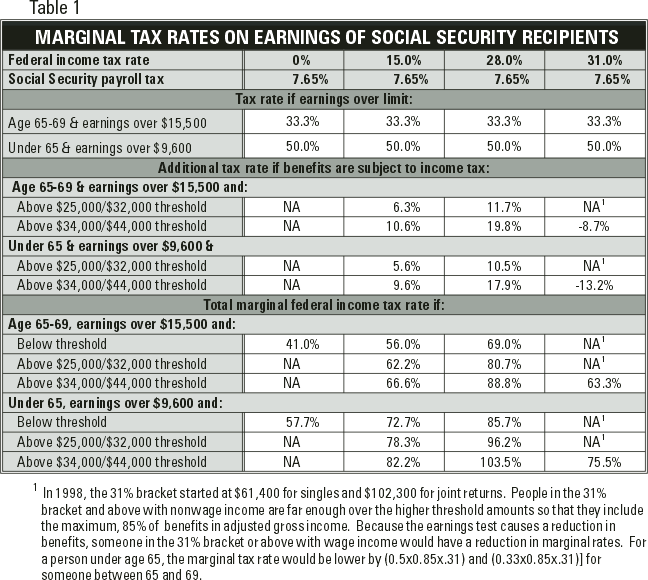
Such high, punitive tax rates on working may help explain why, despite improved health among retirees, only 16.5 percent of men age 65 and over are in the labor force today compared to 47 percent fifty years ago. [See Figure 1 for the labor force participation rates of men and women age 65 and over since 1948.]
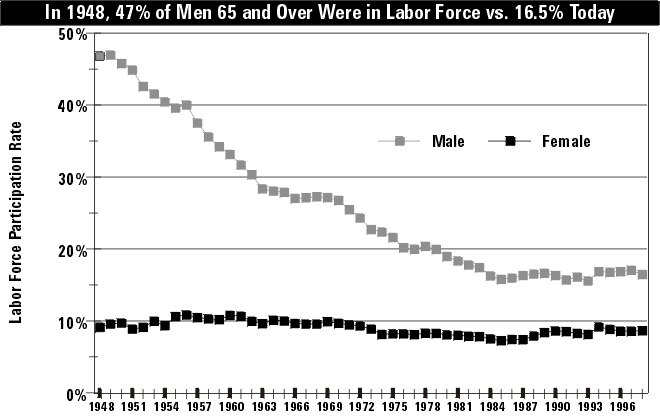
The 1996 Bill Took a Large Bite Out of the Earnings Test
Like the Social Security taxable wage base, the earnings limit goes up each year with the growth in average wages. The “Senior Citizens’ Right To Work Act of 1996” temporarily allowed a faster increase in the earnings limit for retired workers between 65 and 69.1 By 2002, they will be able earn up to $30,000 without penalty. After that, the earnings limit will revert to rising with wage growth. [See Table 2 for the earnings limit under old (pre-1996) and new law.]
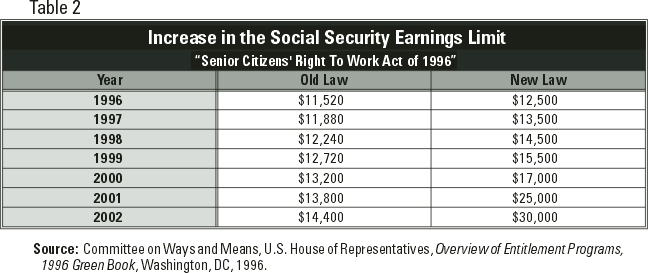
About one in three people eligible for retired-worker benefits and between the ages of 65 and 69 work sometime during the year.2 Before 1996, 65 percent of those who did kept their earnings under the limit. Almost half (45%) of retired workers between 62 and 64 have wage income and most of them (61%) also keep their earnings under the limit.3 [See Figure 2.]
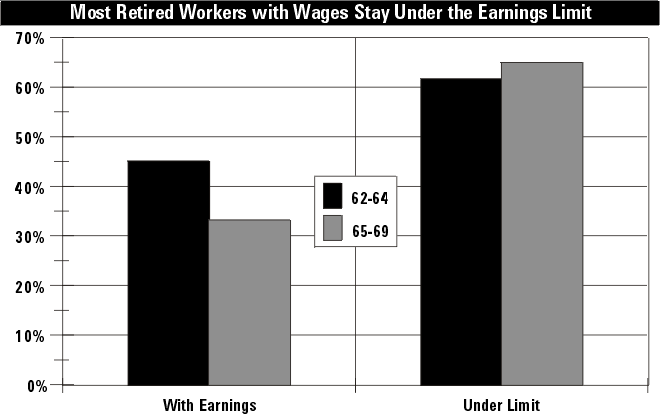
But, because of the 1996 change, an even larger share of retired workers between 65 and 69 will have earnings that stay under the limit. By 2002, 87 percent should avoid losing benefits because of the retirement earnings test. [See Figure 3.]
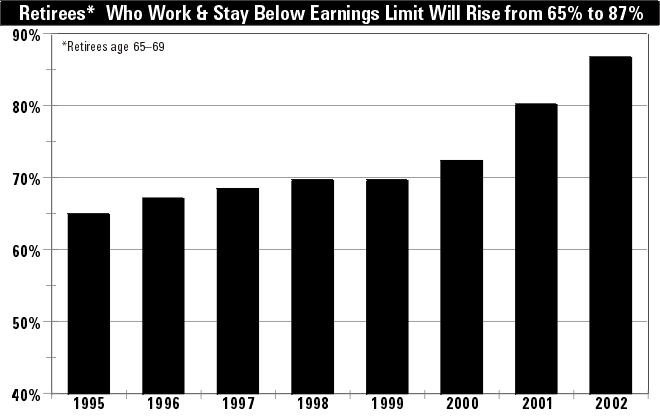
What Would Outright Elimination Do?
The main obstacle to eliminating the earnings limit has been the cost. According to the Social Security Administration, $3.9 billion in benefits will be withheld from beneficiaries ages 65 to 69 during fiscal year 1999.4 After 2000, however, the cost of letting retirees earn as much as they want without penalty will decline for two reasons. One is the increase in the earnings limit which Congress enacted in 1996.
The other is the delayed retirement credit which increases benefits for people who postpone retirement past the normal age – currently 65.5 For someone turning 65 this year, the credit would increase benefits by 5.5 percent for each year he or she puts off applying for Social Security, up to a maximum of 27.5 percent at age 70. The credit will continue to increase gradually until reaching 8 percent in 2008.
Retired workers losing benefits for a month or more now because they exceed the earnings limit will have their benefits boosted later thanks to the credit. By the time the credit reaches its final level of 8 percent in the year 2008, benefits withheld between age 65 and 69 because of the earnings test will be about the same as higher benefits paid out after age 70 because of the delayed retirement credit. In other words, the long-run costs of eliminating the earnings limit are almost nothing.
Moreover, because of several offsets, the net cost to the federal government is less than the extra benefits Social Security will pay out.6 Most significant is the increased income taxes collected on benefits no longer withheld. Total offsets would lower the cost of eliminating the earnings limit from $20.7 billion to $14.9 billion between 1999 and 2006.
Economic Effects
Even the short-run costs of the proposal are overstated, however. Marginal tax rates on wages of 40 percent to 80 percent or more discourage people ages 65 to 69 from working. As discussed earlier, two out of three people receiving Social Security benefits do not work, and of those that do, two out of three keep their earnings low enough so that they don’t lose any benefits.
Eliminating the earnings limit in 1999 would reduce the marginal tax rate on working for people 65 to 69. If they respond the same way other workers do to higher take-home pay, they would supply more of their labor services.7 By 2008, we estimate that, economy-wide, there would be 63 million more hours worked than otherwise.8 That translates into almost 31,500 more full-time equivalent jobs. [See Table 3 for economic effects of eliminating the earnings test.]
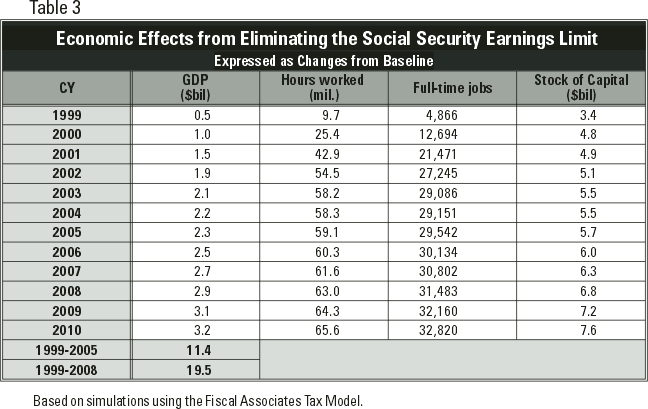
The increase in hours worked would produce several positive effects. First, there would be more investment to go along with the increase in employment and more total output for the economy. By 2008, we estimate GDP would increase by $19.5 billion and the stock of U.S. capital would be $6.8 billion higher than otherwise.
This extra growth would generate new federal payroll, income, and excise taxes that would offset some of the cost. By 2010, the added revenue would be enough to offset higher benefit payments from removing the limit on earnings. [See Table 4 for federal budget effects of eliminating the earnings test.]
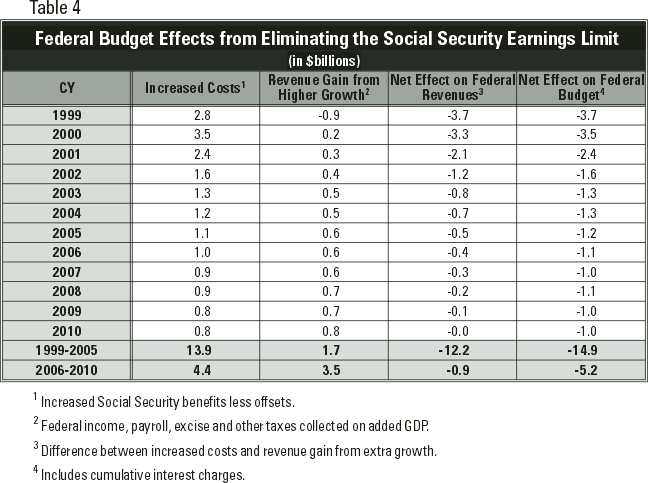
Conclusion
A relic from a time when jobs were scarce, the Social Security earnings test has no place in today’s economy. In fact, quite the opposite. Companies already have trouble filling positions, particularly ones calling for skilled labor. Government analysts project the economy will add 19 million new jobs between now and 2006 but the labor pool will grow by just 15 million. With labor shortages like these, government policy should not prevent retired workers from entering the labor market or cause them to restrict the number of hours they work.
The change Congress enacted in 1996 has already gone a long way toward removing Social Security’s penalty against work. With a low price tag, burgeoning federal budget surpluses and the economy’s need for talented workers, now is the time to finish the job and totally repeal the earnings test.
Endnotes
- Incorporated into Public Law 104-121, the Contract With America Advancement Act of 1996.
- Out of 9.5 million people entitled to retired worker benefits and under the age of 70 in 1993, about 3.5 million had earnings from work. Committee on Ways and Means, U.S. House of Representatives, Overview of Entitlement Programs, 1996 Green Book, Washington, DC, 1996.
- Computed using 1993 data from the 1996 Green Book , Table 1-15 and the Social Security Bulletin, Annual Statistical Supplement, 1998, Table 15.B.
- Social Security Administration, Office of the Actuary, “Estimated changes in OASDI and HI income and outgo from a proposal to eliminate the earnings test for beneficiaries above the normal retirement age in 1999, August 4, 1998.
- Instituted in 1972, the credit increased the Social Security benefit by one percent for every year a worker put off retiring until age 70. Between 1982 and 1989, the credit was increased to 3 percent a year. Starting in 1990, the credit is gradually being raised to 8 percent by the year 2008.
- Other offsets are a reduction in administrative expenses, increased work effort and reduced Medicare Part A payments because private health insurance pays first.
- This assumption is conservative because retired workers are more responsive to changes in aftertax wages than prime-age workers. One estimate found that the elderly are 2.5 times as sensitive to tax rates as adult male workers under age 62. See Robert Haveman, "How Much Have the Reagan Administration's Tax and Spending Policies Increased Work Efforts?," in Charles R. Hulten and Isabel V. Sawhill, eds., The Legacy of Reaganomics: Prospects for Long-Term Growth, Washington, DC: The Urban Institute Press, 1984.
- We used our neoclassical, general equilibrium model of the U.S. economy to assess the macroeconomic effects of eliminating the earnings test. The results are expressed as changes from a baseline, that is, a forecast of how the economy would perform if there were no change in policy. Our baseline, which is similar to those of the Congressional Budget Office and the Office of Management and Budget, projects the U.S. economy will average 2.5 percent growth annually over the next decade. Economy-wide, the marginal tax rate on labor would fall by 0.05 percentage points, a decline of 0.4 percent. For more on the Fiscal Associates Model see Gary and Aldona Robbins, Accounting for Growth: Incorporating Dynamic Analysis into Revenue Estimation , Lewisville, TX: Institute for Policy Innovation, Policy Report No. 138, July 1996
